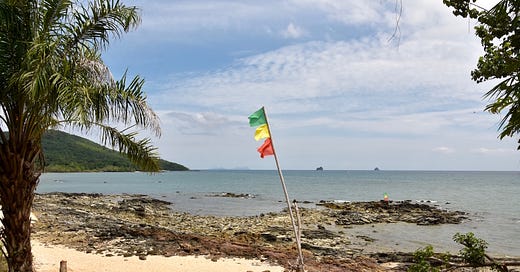T.I.C.D.: Krabi coast & offshore islands (Part I: Mueang Krabi, Railay, Ao Nang & Khlong Muang)
The busy middle shorelines of Krabi province, condensed.
Welcome back to the Thai Island & Coastal Directory, a book-in-progress that promises to be the most complete guide to coastal Thailand ever written in English, covering more than 800 islands and all 24 coastal provinces. It is being released piecemeal (four sections monthly) here at Thai Island Quest.
For info on how to use the T.I.C.D. and a working Table of Contents, paddle here. To view all previously published sections, see the welcome page.
T.I.C.D. ticker: So far, we’ve covered 426 islands and 155 notable mainland areas in 33 sections, including this one.
Resuming Krabi province…
In this section we begin digging into the scenic mainland coasts along with those islands set close to shore and within the estuaries of Krabi.
Krabi provincial coast, offshore islands and inland reaches
The Krabi coast extends for some 150 km between Phang Nga in the N and Trang down S, though it can be difficult to discern the actual mainland coasts from the offshore islands, estuary isles and capes. Many experienced travelers feel that Krabi, given its scenic shores and 170+ islands to go with jungle areas and viewpoints away from the sea, is the most dazzling of Thailand’s 77 provinces.
The geographical and cultural variation that you can experience on a single day in Krabi is remarkable. You can admire towering massifs, bushy mangroves and prehistoric paintings in some dreamy caves. You might spot Muslim farmers tending to their buffalos before perusing a calming wat or diving into a pub crawl. You can soak in waterfalls of both the cool and hot-spring variety, gaze from some of the South’s most breathtaking viewpoints, learn to climb immense cliffs, trek upon mountain ridges, explore markets bursting with fiery Southern curries and piles of fresh seafood — and all of that only scratches the surface.
Mind you, all of the above does not even include Krabi’s islands and dive sites, from Mu Ko Phi Phi and Mu Ko Poda in the middle, to Mu Ko Hong and other Ao Phang Nga isles up N, and to Mu Ko Si Boya and Mu Ko Lanta in the S — not to mention the dozens of other islands found closer to shore and amid the estuaries.
It is true that Ao Nang is too touristy and developed for many, but I appreciated its multicultural food and shopping when staying in Khlong Haeng, a predominantly Muslim village just N of Ao Nang, for much of 2018-19. Muslims, Buddhists and Christians; Urak Lawoi boat drivers and small business owners from Bangkok, Isaan, India, Myanmar and beyond; native fisher folk, expats from around the world, backpackers, divers, climbers and luxury seekers — they are all in Krabi.
It is helpful for me to break the Krabi coast down into a few quadrants. In the N you have Ao Luek (don’t spell it ‘Leuk’!) and its many karst isles and caves amid the E coast of Ao Phang Nga. Then you have Krabi’s popular middle coast including Ao Nang, Railay and the provincial capital, commonly known as Krabi town.And finally you have the more rural S districts where you can catch boats to Ko Si Boya, Ko Jum / Pu, and, way down near the Trang border, Ko Lanta.
This 4,709 sq.-km province has a bunch of protected areas. Than Bok Khoranni NP covers its namesake waterfall and several caves in Ao Luek, plus all of Mu Ko Hong. Hat Noppharat Thara - Mu Ko Phi Phi NP oversees its namesake beach and parts of Railay along with Ao Nammao’s fossil beach — plus all of Mu Ko Poda and much of Mu Ko Phi Phi. Then you have Khao Phanom Bencha NP found up province, while Khao Ngon Nak Forest Park is named after the ‘Dragon’s Crest’ ridge near Khlong Muang. Much further S, Khao Pra Bang Khram Wildlife Sanctuary is home to the ‘Emerald Pool,’ and Mu Ko Lanta NP has several isles of its own. There is also the Thung Thale Wildlife Sanctuary amid the quiet shores N of Lanta.




